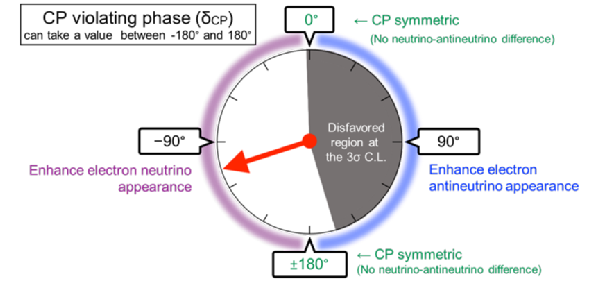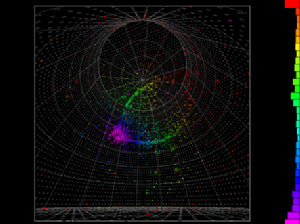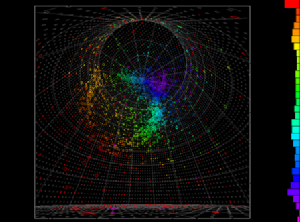T2K results restrict possible values of neutrino CP phase
- Published in Nature, the results are a major step forward in the study of difference between matter and antimatter
Scientists are a step closer to determining whether neutrinos and anti-neutrinos behave differently – potentially solving a key question about the creation of our universe – thanks to new results from an international experiment involving particle physicists at the University of Warwick.
The T2K Collaboration has published new results showing the strongest constraint yet on the parameter that governs the breaking of the symmetry between matter and antimatter in neutrino oscillations. Using beams of muon neutrinos and muon antineutrinos, T2K has studied how these particles and antiparticles transition into electron neutrinos and electron antineutrinos, respectively. The parameter governing the matter/antimatter symmetry breaking in neutrino oscillation, called the CP-violating phase, δcp, can take a value from -180º to 180º. For the first time, T2K has disfavored almost half of the possible values at the 99.7% or 3 standard deviations level (3σ), and is starting to reveal a basic property of neutrinos that has not been measured until now. This is an important step on the way to knowing whether or not neutrinos and antineutrinos behave differently. These results, using data collected through 2018, have been published in the multidisciplinary scientific journal, Nature on April 16.
At the University of Warwick, scientists from the Department of Physics contributed to the development of software to perform sensitive searches for matter-antimatter asymmetry in neutrino oscillations and played a key role in the analysis to extract the neutrino CP phase itself.
Professor Gary Barker, Head of the Particle Physics Group at the University of Warwick said: "This is an important and tantalising result. The Warwick Neutrino Group are delighted to have been involved in this measurement. In particular, we would like to highlight the work of Dr Andrew Chappell who played a significant role in what is a very detailed analysis of the T2K data, and Dr David Hadley, who leads one of the T2K analysis groups.''
For most phenomena, the laws of physics provide a symmetric description of the behavior of matter and antimatter. However, this symmetry does not hold universally. The effect of the asymmetry between matter and antimatter is most apparent in the observation of the universe, which is composed of matter with little antimatter. It is predicted that equal amounts of matter and antimatter were created at the beginning of the universe. Then, for the universe to evolve to a state where matter dominates over antimatter, a necessary condition is the violation of the so-called Charge-Parity (CP) symmetry. Until now, CP symmetry violation has only been observed in the physics of subatomic particles called quarks, but the magnitude of the CP symmetry violation is not large enough to explain the observed dominance of matter over antimatter in the universe. T2K is now searching for a new source of CP symmetry violation in neutrino oscillations that would manifest as a difference in the measured oscillation probability for neutrinos and antineutrinos.

Fig.1 The arrow indicates the value most compatible with the data. The gray region is disfavored at 99.7% (3s) confidence level. Nearly half of the possible values are excluded.
The T2K experiment uses a beam consisting primarily of muon neutrinos or muon antineutrinos created using the proton beam from the Japan Proton Accelerator Research Complex (J-PARC) located in Tokai village on the east coast of Japan. A small fraction of the neutrinos (or antineutrinos) are detected 295 km away at the Super-Kamiokande detector, located under a mountain in Kamioka, near the west coast of Japan. As the muon neutrinos and muon antineutrinos traverse the distance from Tokai to Kamioka (hence the name T2K), a fraction will oscillate or change flavor into electron neutrinos or electron antineutrinos respectively. The electron neutrinos and electron antineutrinos are identified in the Super-Kamiokande detector by the rings of Cherenkov light that they produce (shown below). While Super-Kamiokande cannot identify each event as a neutrino or antineutrino interaction, T2K is able to study the neutrino and antineutrino oscillations separately by operating the beam in neutrino mode or antineutrino mode.


Fig.2 Event displays of candidate electron neutrino (left) and electron antineutrino (right) events observed in Super-K from the T2K neutrino beam. When an electron neutrino or antineutrino interacts with water, an electron or positron is produced. They emit a faint ring pattern light, which is detected by about 11,000 photo-sensors. The color in the displays represents the photon detection timing.
T2K released a result analysing data with 1.49x1021 and 1.64x1021 protons from the accelerator for neutrino beam mode and antineutrino beam mode respectively. If the parameter δcp equals 0º or 180º, the neutrinos and antineutrinos will change their types (from muon to electron) in the same way during oscillation. The δcp parameter may have a value that enhances the oscillations of neutrinos or antineutrinos, breaking CP symmetry. However, the observation of neutrinos is already enhanced in the T2K experiment by the fact that the detectors and beam line components are made out of matter and not antimatter. To separate the effect of δcp from known beam line and interaction effects, the T2K analysis includes corrections based on data from magnetized near detectors (ND280) placed 280m from the target. T2K observed 90 electron neutrino candidates and 15 electron antineutrino candidates. T2K expects to observe 82 electron neutrino events compared to 17 electron antineutrino events for maximal neutrino enhancement (δcp =-90º) and 56 electron neutrino events compared to 22 electron antineutrino events for maximal antineutrino enhancement (δcp=+90º). The observed number of events as a function of the reconstructed neutrino energy is shown below. The T2K data is most compatible with a value close to δcp=-90º that significantly enhances the oscillation probability of neutrinos in the T2K experiment. Using this data, T2K evaluates confidence intervals for the parameter δcp. The disfavored region at the 3σ (99.7%) confidence level is -2º to 165º. This result represents the strongest constraint on δcp to date. The values of 0º and 180º are disfavored at 95% confidence level , which was the case in T2K’s previous release in 2017, indicating that CP symmetry may be violated in neutrino oscillations.

Fig.3 The observed electron neutrino (left) and electron antineutrino (right) candidate events with predictions for maximal neutrino enhancement (red, long dash) and maximum antineutrino enhancement (blue, short dash).
While this result shows a strong preference for enhancement of the neutrino rate in T2K, it is not yet clear if CP symmetry is violated or not. To further improve the experimental sensitivity to a potential CP symmetry violating effect, the T2K Collaboration will upgrade the near detector suite to reduce systematic uncertainties and accumulate more data, and J-PARC will increase the beam intensity by upgrading the accelerator and beamline.
The T2K experiment is supported by the Japanese Ministry for Culture, Sports, Science, and Technology (MEXT), and is jointly hosted by the High Energy Accelerator Research Organization (KEK) and the University of Tokyo’s Institute for Cosmic Ray Research (ICRR). The T2K experiment was constructed and is operated by an international collaboration, which currently consists of nearly 500 scientists from 68 institutions in 12 countries [Canada, France, Germany, Italy, Japan, Poland, Russia, Spain, Switzerland, UK, USA and Vietnam]. This result is made possible by the efforts of J-PARC to deliver high-quality beam to T2K.
More information about the T2K experiment can be found on the T2K public website (http://t2k-experiment.org).
- This research was supported in the UK by the Science and Technology Facilities Council (STFC).
Ends
15 April 2020
University of Warwick press office contact:
Peter Thorley
Media Relations Manager (Warwick Medical School and Department of Physics)
Email: peter.thorley@warwick.ac.uk
Tel: +44 (0)24 761 50868
Mob: +44 (0) 7824 540863
